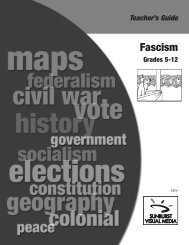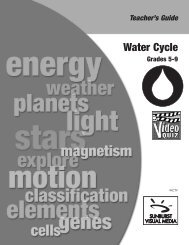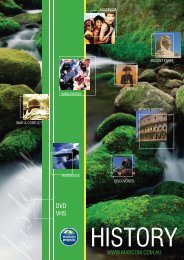Thrilling Experiments: Potential and Kinetic Energy
Thrilling Experiments: Potential and Kinetic Energy
Thrilling Experiments: Potential and Kinetic Energy
You also want an ePaper? Increase the reach of your titles
YUMPU automatically turns print PDFs into web optimized ePapers that Google loves.
Extensions<br />
• Clipped Car Investigation<br />
Distribute the following materials to each group of students: a 30-inch length of string, a<br />
small, freely rolling toy car, a paper clip opened to serve as a hook, a variety of weights<br />
that can be attached to the paper-clip hook, <strong>and</strong> a stopwatch. Divide the class into small<br />
groups, distributing the necessary materials to each group. Instruct students to set up their<br />
experiment by tying one end of the string onto the toy car <strong>and</strong> the other end to the paperclip<br />
hook. Have students place their cars on a flat table or desktop <strong>and</strong> hang the paperclip<br />
hook over the edge of the table. Calling attention to the variety of weights each group<br />
has been given, ask students to predict how the cars will move if different weights are hung<br />
from the paper-clip hook <strong>and</strong> allowed to fall to the floor. Possible predictions might include:<br />
(1) as the weight increases, the car will move with increasingly higher constant speeds<br />
toward the edge of the table; (2) different weights will have no effect on how the car<br />
moves; (3) as the weight increases, the car will move toward the edge of the table with<br />
greater <strong>and</strong> greater acceleration. (Correct prediction: the car will move with greater<br />
acceleration as the weight increases.) After students have made their predictions, ask them<br />
to support them by creating illustrated diagrams using arrows <strong>and</strong> labels to indicate the<br />
forces <strong>and</strong> counter forces acting on the car. Once the charts are complete, have students<br />
conduct experiments using the cars, weights, <strong>and</strong> stopwatch to confirm or refute their<br />
predictions. Students should record the results of their experiments. Extension/Challenge:<br />
Challenge them to determine a mathematical relationship between the mass of the car <strong>and</strong><br />
the weight of the object attached to the paper-clip hook.<br />
• Gravity Writing<br />
Initiate a class discussion about gravity <strong>and</strong> how it affects us each day. Now ask students<br />
to write a short story about what a typical day would be like if there was no gravitational<br />
force. Students must include descriptions of normal activities, such as eating meals,<br />
sleeping, going to school, participating in a sport, etc.<br />
• Science at the Dam<br />
Students can study the development of hydroelectric dams in the Tennessee Valley <strong>and</strong> the<br />
Northwest used to turn the potential energy <strong>and</strong> kinetic energy of falling water to produce<br />
electrical energy to do work. Students can then listen to <strong>and</strong> read the lyrics of Woodie<br />
Guthrie's songs about the Columbia River <strong>and</strong> the Gr<strong>and</strong> Coulee Dam. Students may also<br />
read <strong>and</strong> discuss Ken Kesey's vivid <strong>and</strong> physically accurate description of a downhill<br />
escape on a railroad h<strong>and</strong>car, in the novel A Sailor Song.<br />
© Sunburst Visual Media, a division of Global Video, LLC <strong>Thrilling</strong> <strong>Experiments</strong>: <strong>Potential</strong> <strong>and</strong> <strong>Kinetic</strong> <strong>Energy</strong><br />
Additional<br />
Resources<br />
23











